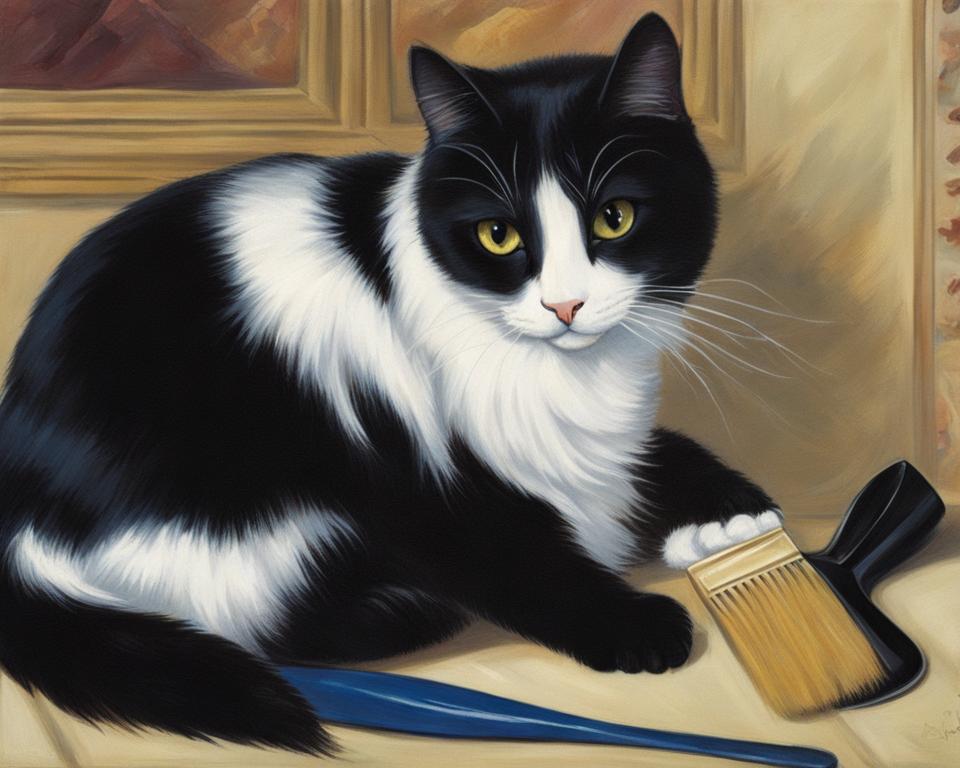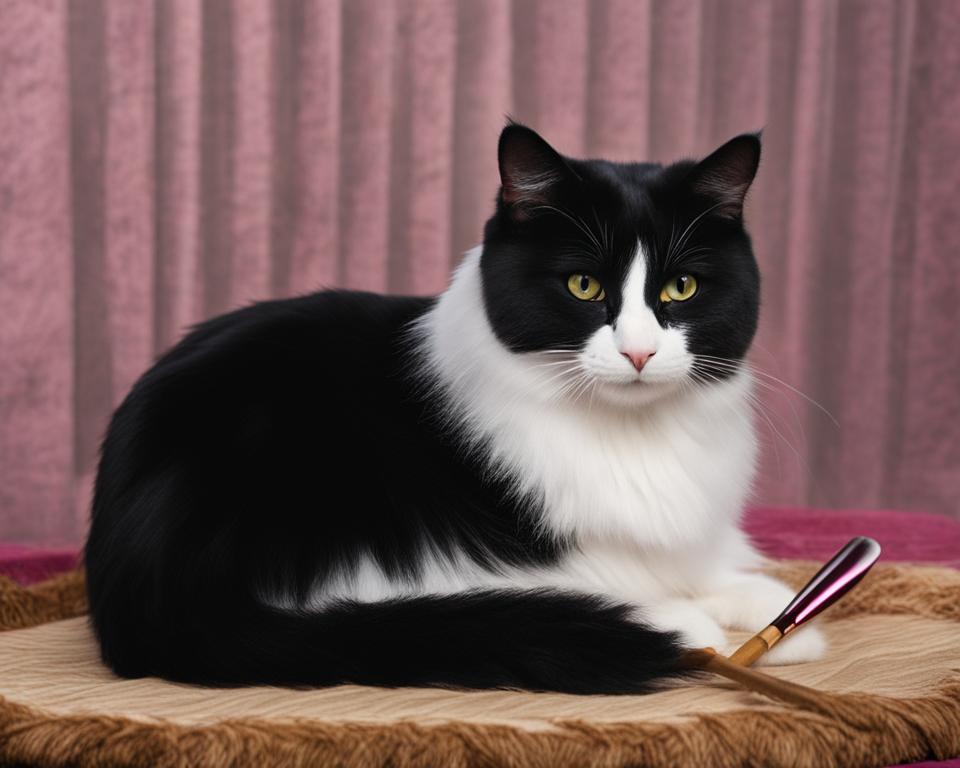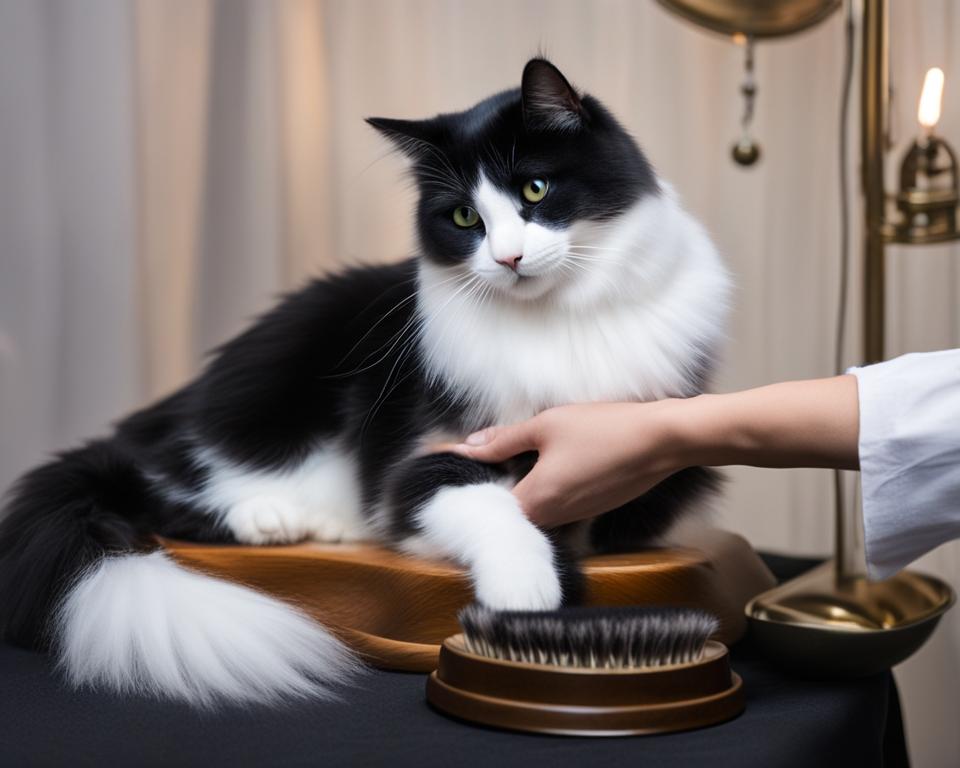Grooming a tuxedo cat requires patience, appropriate tools, and techniques. Understanding the cat’s grooming resistance is crucial. Selecting the right grooming tools and products tailored to the cat’s needs is important. Creating a calm environment and setting the stage for a positive grooming experience is essential. Strategies for grooming a difficult cat include starting with short sessions, slowly introducing grooming tools, gentle handling, and positive reinforcement. Handling mat removal in resistant cats requires regular combing and bathing. Seeking professional grooming assistance may be necessary in certain situations.
Key Takeaways:
- Tuxedo cats require specific grooming techniques and tools.
- Creating a calm environment is crucial for successful grooming sessions.
- Starting with short sessions and positive reinforcement can help groom difficult cats.
- Regular combing and bathing are necessary to prevent mat formation.
- Professional grooming may be needed in certain situations.
Understanding Your Cat’s Grooming Resistance
Grooming a tuxedo cat can sometimes be challenging due to their resistance to the grooming process. It is crucial to understand the reasons behind this resistance in order to address them effectively. There can be several factors contributing to a cat’s hesitation towards grooming, including past negative experiences, discomfort, and underlying health issues.
Cats that have had previous negative experiences during grooming may develop fear or aggression, making them resistant to any grooming attempts. It is important to approach grooming sessions with patience and create a calm environment to help alleviate these fears. Additionally, cats may resist grooming if they are experiencing discomfort, such as skin irritations, matting, or pain caused by underlying health conditions like arthritis.
Recognizing the signs of grooming resistance in your cat is crucial. These signs may include vocalization, aggression, hiding, excessive grooming, or attempts to escape. By identifying and addressing the underlying cause of the resistance, you can work towards finding effective solutions to make the grooming experience more pleasant for your tuxedo cat.
Addressing Grooming Resistance in Cats
To address grooming resistance in cats, it is important to approach the process gradually and with understanding. By introducing your cat to grooming tools and techniques slowly, you can help them become more comfortable over time. Start with short grooming sessions and gradually increase the duration as your cat becomes more familiar and relaxed.
Positive reinforcement plays a vital role in overcoming grooming resistance. Reward your cat with treats, praise, or play after successful grooming sessions to create positive associations. Additionally, providing a calm and quiet grooming environment, using gentle handling techniques, and seeking professional assistance if needed can all contribute to a stress-free grooming experience for your tuxedo cat.

| Reasons for Grooming Resistance: | Addressing Grooming Resistance: |
|---|---|
| Past negative experiences | Approach grooming gradually |
| Discomfort | Create a calm environment |
| Health issues | Seek professional assistance if needed |
Setting the Stage for a Positive Grooming Environment
Grooming a tuxedo cat requires creating a calm and comfortable environment to ensure a positive grooming experience. By selecting the right tools and products tailored to your cat’s specific needs, you can help make grooming sessions more enjoyable for both you and your feline companion.
Choosing the Right Tools and Products
When it comes to grooming a tuxedo cat, selecting the appropriate tools and products is essential. Wide-toothed combs are ideal for cats with longer fur, while slicker brushes are effective for removing loose hair and tangles. Grooming gloves can be a gentle way to massage and remove excess hair from your cat’s coat. Additionally, investing in cat-safe shampoos and degreasing products can contribute to a healthy and lustrous coat.
Creating a Calm Environment
A calm and stress-free grooming environment is crucial for tuxedo cats, especially those who may be resistant to grooming. Choose a quiet space free from distractions where your cat feels safe and secure. Maintain a comfortable room temperature to ensure your cat’s comfort. Using a non-slip surface such as a grooming mat or towel can help prevent your cat from sliding or feeling unstable during the grooming process. Remember to handle your cat gently and speak in soothing tones to help create a relaxed atmosphere.
Practicing Gentle Handling
Gentle handling is key to ensuring a positive grooming experience for your tuxedo cat. Take your time, allowing your cat to become accustomed to the grooming process gradually. Start with short grooming sessions and gradually increase the duration as your cat becomes more comfortable. Use positive reinforcement such as treats or praise to reward your cat for good behavior during grooming. Remember to always be patient, understanding, and respectful of your cat’s boundaries.

| Grooming Tools | Best for |
|---|---|
| Wide-toothed comb | Long-haired tuxedo cats |
| Slicker brush | Removing loose hair and tangles |
| Grooming gloves | Gentle massage and hair removal |
| Cat-safe shampoo | Keeping the coat clean and healthy |
Grooming Strategies for Difficult Cats
Grooming a cat that is resistant or difficult requires a strategic approach to ensure a stress-free experience for both the cat and the caregiver. These grooming techniques can help you navigate the challenges of grooming a skittish or resistant tuxedo cat:
- Start with short, manageable sessions: Begin by introducing grooming in small increments to acclimate your cat to the process. Start with a quick brush or gentle touch and gradually increase the duration of each session as your cat becomes more comfortable.
- Allow for familiarization: Allow your cat to investigate grooming tools such as brushes, combs, and nail clippers by sniffing and examining them. This helps create positive associations and reduces anxiety during grooming sessions.
- Practice gentle handling: Handle your cat with care and gentleness during grooming. Avoid applying excessive force or pressure, and be mindful of sensitive areas such as the ears and tail. Use slow, deliberate movements to minimize stress.
- Utilize positive reinforcement: Reward your cat with treats, praise, or a favorite toy after each grooming session to reinforce positive behavior. This encourages your cat to associate grooming with positive experiences, making future sessions more manageable.
Remember that each cat is unique, and what works for one may not work for another. It’s essential to customize your grooming approach based on your cat’s temperament and individual needs. If you’re struggling to groom your tuxedo cat effectively, consider seeking assistance from a professional groomer or veterinarian who specializes in cat care.
Grooming a difficult cat can be challenging, but with patience, understanding, and the right techniques, you can create a stress-free grooming experience that keeps your tuxedo cat looking and feeling their best.
Tackling Specific Grooming Challenges
Grooming tuxedo cats comes with its own set of challenges, particularly when it comes to handling mat removal. Long-haired and senior cats are prone to mat formation, which requires regular combing and bathing to prevent them from becoming unmanageable. Attempting to cut out mats with scissors can be dangerous for a cat’s delicate skin. Instead, specialized grooming tools like dematting combs or rakes are recommended for gentle mat removal, ensuring the cat’s safety and comfort.
When it comes to preventing mat formation in resistant cats, a proactive approach is key. Regular combing sessions not only help maintain a tangle-free coat but also provide an opportunity to bond with your furry friend. Introduce combing as part of your cat’s grooming routine, starting with short sessions and gradually increasing the duration as your cat becomes more comfortable. Comb through the fur gently, paying extra attention to areas prone to matting, such as the armpits, belly, and behind the ears.
Table: Common Grooming Challenges in Cats and Techniques for Overcoming Them
| Grooming Challenge | Overcoming Technique |
|---|---|
| Mat Formation | Regular combing with dematting tools |
| Resistant Cats | Gradual introduction to grooming and positive reinforcement |
| Sensitive Areas | Gentle handling and desensitization |
| Nail Trimming | Positive reinforcement and using specialized cat nail clippers |
Tackling specific grooming challenges in cats requires a tailored approach based on their individual temperament and health conditions. For instance, for cats with a high grooming resistance, desensitization techniques can be employed to gradually acclimate them to being touched and groomed in sensitive areas. This involves starting with gentle touches in non-sensitive areas and gradually progressing to more sensitive areas over time. Pairing each grooming session with positive reinforcement, such as treats or praise, can help create positive associations and make the grooming experience more enjoyable for your tuxedo cat.
Remember, patience and understanding are key when facing grooming challenges with your tuxedo cat. By customizing grooming techniques, addressing grooming challenges promptly, and providing a stress-free environment, you can ensure that your feline companion looks and feels their best.

Techniques for a Stress-Free Experience
Grooming can be a challenging experience for tuxedo cats, but with the right techniques, it can be transformed into a stress-free process. Gradual introduction and positive reinforcement are key to helping your cat adjust to grooming routines. Start by introducing grooming tools gradually, allowing your cat to sniff and explore them at their own pace. This helps create positive associations and reduces anxiety.
Creating a calm grooming environment is crucial for a stress-free experience. Choose a quiet and comfortable space where your cat feels relaxed. Consider using soothing techniques like playing soft music or using calming sprays to create a serene atmosphere. Patience and understanding are essential during grooming sessions, as your cat may require breaks or reassurance. By prioritizing your cat’s well-being and ensuring they feel safe, you can significantly reduce grooming anxiety.
If you’re facing difficulties in grooming your tuxedo cat, don’t hesitate to seek professional help. Veterinarians, trained groomers, or behaviorists can provide valuable guidance and support. They have the expertise to handle resistant cats and can offer advice tailored to your cat’s specific needs. Remember, the ultimate goal is to ensure a stress-free grooming experience for your tuxedo cat, promoting their overall well-being.
FAQ
What tools and techniques are needed to groom a tuxedo cat?
Grooming a tuxedo cat requires patience, appropriate tools, and techniques. Understanding the cat’s grooming resistance is crucial. Selecting the right grooming tools and products tailored to the cat’s needs is important. Creating a calm environment and setting the stage for a positive grooming experience is essential.
Why do cats resist grooming and how can it be addressed?
Cats may resist grooming for various reasons, including past negative experiences, discomfort, and health issues. It’s important to recognize signs of resistance and address underlying issues before grooming. Common reasons for grooming resistance include fear or aggression from past experiences, discomfort, and decreased self-grooming due to health issues such as arthritis. Assessing the cat’s temperament and needs helps in understanding their state of health and selecting appropriate grooming methods.
What are the essential tools and products for grooming a tuxedo cat?
A successful grooming session starts with selecting the right tools and products tailored to the cat’s coat type and skin sensitivity. Wide-toothed combs, slicker brushes, and grooming gloves are effective tools for different fur types. Cat-safe shampoos and degreasing products contribute to a healthy coat. Creating a calm environment involves choosing a quiet space, maintaining a comfortable room temperature, providing a non-slip surface, and practicing gentle handling.
How can a difficult cat be groomed effectively?
Grooming a difficult cat requires a well-crafted strategy. Starting with short, manageable sessions helps ease skittish cats into the grooming experience. Allowing cats to familiarize themselves with grooming tools through sniffing and examination creates positive associations. Gentle handling and positive reinforcement with treats and praise encourage cooperation. Customizing grooming strategies based on individual cat’s needs is important, considering factors like temperament and health conditions.
How can specific grooming challenges like mat removal be tackled in cats?
Long-haired and senior cats are prone to developing mats, requiring regular combing and bathing to prevent them. Attempting to cut out mats with scissors can be dangerous for a cat’s skin. Specialized grooming tools like dematting combs or rakes can be used for gentle mat removal. Overcoming common grooming challenges involves customizing grooming styles based on temperament and health conditions. Lion cuts, comb cuts, de-shedding, and dematting are some grooming styles relevant to tackling specific grooming challenges in cats.
What techniques can be used to create a stress-free grooming experience?
Grooming can be a source of anxiety for pets, but techniques can help create a stress-free experience. Gradual introduction and positive reinforcement help pets transition to grooming routines. Grooming in a calm environment, using soothing techniques like soft music or calming sprays, and being patient and understanding are effective strategies. Seeking professional help from veterinarians, trained groomers, or behaviorists may be necessary in some cases. Prioritizing a pet’s well-being and ensuring they feel safe throughout the grooming process is important.

Leave a Reply